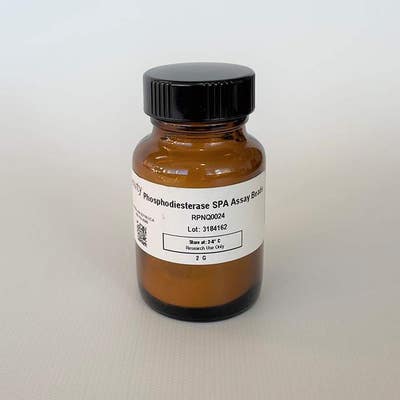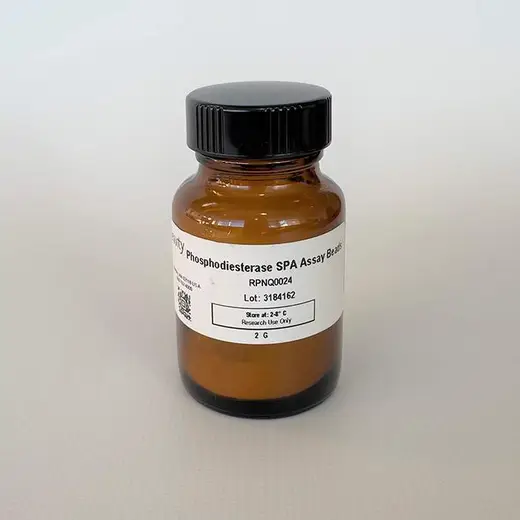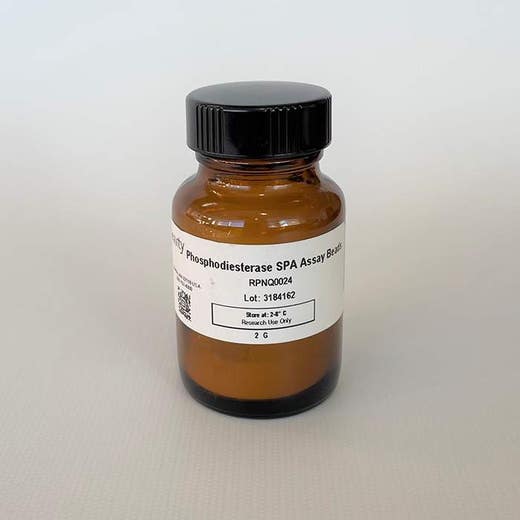
PDE YSI SPA Beads, 2 g

PDE YSI SPA Beads, 2 g




SPA (scintillation proximity assay) beads designed for the capture of [3H]AMP or [3H]GMP on specially prepared yttrium silicate beads.
| Feature | Specification |
|---|---|
| Bead Type or Material | Yttrium Silicate (YSi) |
| Surface Treatment | PDE |
SPA (scintillation proximity assay) beads designed for the capture of [3H]AMP or [3H]GMP on specially prepared yttrium silicate beads.


PDE YSI SPA Beads, 2 g


PDE YSI SPA Beads, 2 g


Product information
Overview
PDE coated yttrium silicate (YSI) SPA (scintillation proximity assay) beads designed for the capture of [3H]AMP or [3H]GMP on specially prepared yttrium silicate beads. 2 gram quantity.
SPA Scintillation beads are microspheres containing scintillant which emit light in the blue region of the visible spectrum. As a result, these beads are ideally suited to use with photomultiplier tube (PMT) counters such as the MicroBeta2 or TopCount.
Two types of core SPA Scintillation bead are available - yttrium silicate (YSi) and Polyvinyltoluene (PVT). PVT beads are plastic, larger in size, and stay in suspension longer than the crystalline YSi beads.
Scintillation proximity assay (SPA) is a homogeneous and versatile technology for the rapid and sensitive assay of a wide range of biological processes, including applications using enzyme and receptor targets, radioimmunoassays, and molecular interactions. When 3H, 14C, 33P, and 125I radioisotopes decay, they release β-particles (or Auger electrons, in the case of 125I). The distance these particles travel through an aqueous solution is dependent on the energy of the particle. If a radioactive molecule is held in close enough proximity to a SPA Scintillation Bead or a SPA Imaging Bead, the decay particles stimulate the scintillant within the bead to emit light, which is then detected in a PMT-based scintillation counter or on a CCD-based imager, respectively. However, if the radioactive molecule does not associate with the SPA bead, the decay particles will not have sufficient energy to reach the bead and no light will be emitted. This discrimination of binding by proximity means that no physical separation of bound and free radiochemical is required.
Specifications
| Application |
Drug Discovery & Development
|
|---|---|
| Automation Compatible |
No
|
| Bead Type or Material |
Yttrium Silicate (YSi)
|
| Brand |
SPA Scintillation Beads
|
| Detection Modality |
Radiometric
|
| Format |
Microplates
Tubes
|
| Instrument Compatibility |
Microbeta2
|
| Shipping Conditions |
Shipped Ambient
|
| Surface Treatment |
PDE
|
| Technology |
Scintillation Proximity Assay
|
| Unit Size |
2 g
|
Resources
Are you looking for resources, click on the resource type to explore further.
Scintillation proximity assay has been successfully applied to receptor binding assays
Loading...


How can we help you?
We are here to answer your questions.






























